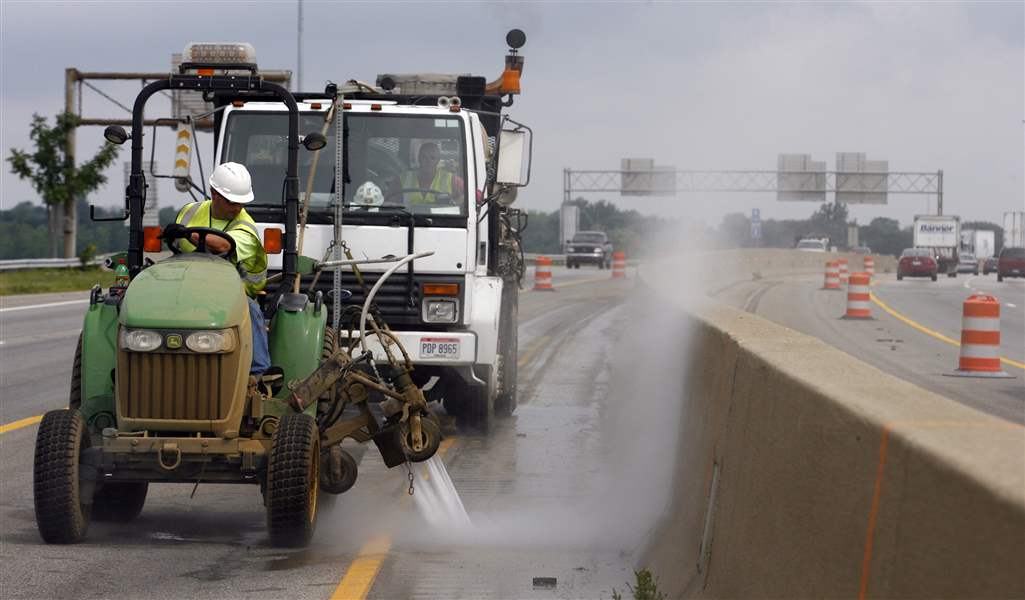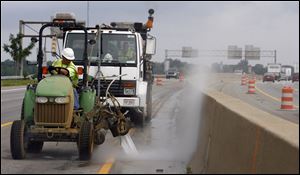
Widening of DiSalle Bridge set to begin in ’17
Project will be unveiled to public on Thursday
1/27/2014
Widening the DiSalle Bridge to eliminate dangerous traffic merges and rebuilding I-75’s Miami Street interchange to have four ramps instead of six are key elements of a project the Ohio Department of Transportation will unveil for public comments Thursday evening.
The Blade
Buy This Image

Widening the DiSalle Bridge to eliminate dangerous traffic merges and rebuilding I-75’s Miami Street interchange to have four ramps instead of six are key elements of a project the Ohio Department of Transportation will unveil for public comments Thursday evening.
Widening the DiSalle Bridge to eliminate dangerous traffic merges and rebuilding I-75’s Miami Street interchange to have four ramps instead of six are key elements of a project the Ohio Department of Transportation will unveil for public comments Thursday evening.
When finished, the centerline of the rebuilt DiSalle, which carries I-75 over the Maumee River, will be 55 feet west of its current location and the bridge will have a fourth lane each way between the South Avenue and Miami interchanges, state officials said last week.
It also will be a bit shorter, because its north end will be at the riverbank instead of at South Avenue. A separate bridge will be built for I-75 to cross South and railroad tracks next to that street.
“This probably will be the last of the I-75 projects,” said Mike Gramza, ODOT’s district construction engineer in Bowling Green. Construction is tentatively scheduled to start in 2017 or 2018, take three years to complete, and cost about $260 million, including inflation and contingency.
That’s more than ODOT spent to build the I-280 Veterans’ Glass City Skyway, although this stage of I-75’s reconstruction through Toledo will include rebuilding the freeway all the way from South to Glenwood Road in Rossford — 3.48 miles in all — not just the DiSalle Bridge remodeling. There are 15 years of inflation to factor in too.
ODOT’s public meeting is scheduled for 4 to 6 p.m. Thursday in the Mayores Senior Center, 2 Aurora L. Gonzalez Dr., South Toledo.
The meeting will have an open-house format, with exhibits about ODOT’s plans and department staff on hand to answer questions but no formal presentation.
The project is likely to be of great interest to people who own or rent homes near the freeway on Sumner Street, South Avenue and, across the river, Linmore and Woodmore streets.
Linmore and Woodmore, short dead-end streets in a small neighborhood bounded by Miami, I-75, and a CSX Transportation railroad yard, now intersect the southbound I-75 entrance at Miami to reach Miami.

That arrangement was modified just two years ago to separate local traffic from ramp traffic, but ODOT now proposes to build a new back-access road for Linmore and Woodmore so they reach Miami at a nearby stoplight that also governs the entrance to Hollywood Casino Toledo.
The back-access road will require condemning at least one house, and rebuilding the freeway entrance may involve another, said Michael Stormer, ODOT’s district planning engineer.
“We’re still pretty rough on what we’re doing here,” he said, adding later that shifting the freeway’s approach to the rebuilt DiSalle bridge could make things “tight in there” along Sumner too.
Realigning the bridge will allow ODOT to keep more I-75 lanes open during its reconstruction. The new lanes farthest to the west will be built first, after which traffic will be shifted onto the new structure while the old is overhauled.
ODOT did major deck repairs on the current bridge in 2009 and 2010 but said that was just a stopgap measure for the aging span, and by the time the new project starts, that repair will be about eight years old.
The rebuilt bridge will have three mainline lanes plus an “add-drop” lane in each direction. The “add-drop” lane will be for motorists using interchange ramps that join or leave I-75 at either end of the bridge. Motorists entering southbound I-75 from South or northbound I-75 from Miami now must merge into traffic in a dangerously short distance or stop on the ramp, which also is perilous.
“Add-drop” lanes also are planned between the Miami and Wales Road interchanges, a section where an I-75 curve will be straightened and a bridge over the CSX yard — which has many fewer tracks than it did at the freeway’s original construction 40 years ago — will be replaced with a shorter span.
The Miami interchange, meanwhile, is to be rebuilt as a four-ramp “diamond” interchange, with two looping clover-leaf ramps eliminated.
“For proper design speeds, they would have to get much larger in radius, which would blow up more of the neighborhood,” Mr. Stormer said. “A diamond with additional turn lanes will handle the capacity while staying in the existing footprint.”
The transportation department previously held similar meetings concerning reconstruction plans for several other sections of I-75 between South and I-280. Work is set to start this spring on the stretch between Dorr Street and Central Avenue, followed next year by sections between Central and I-280, and in 2017 between Dorr and South.
Contact David Patch at: dpatch@theblade.com or 419-724-6094.